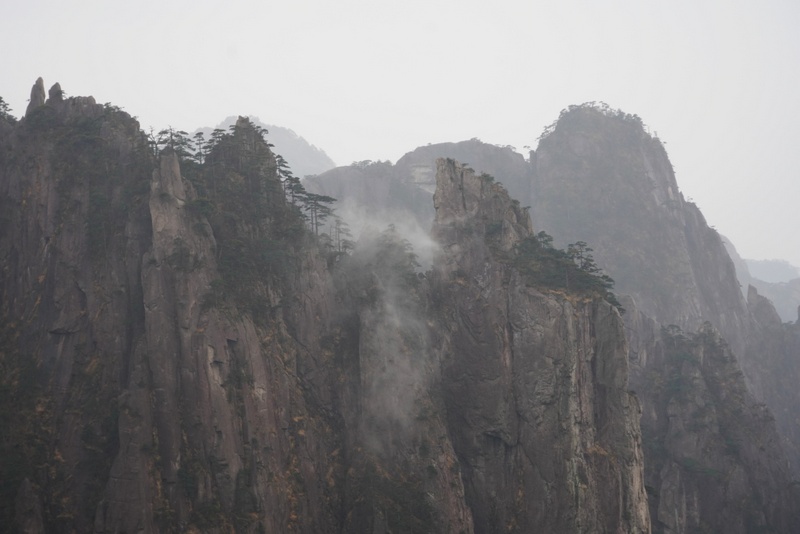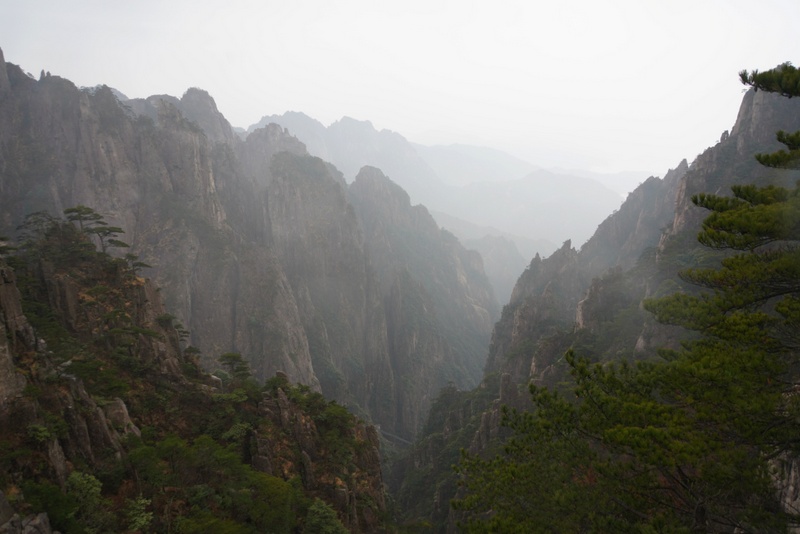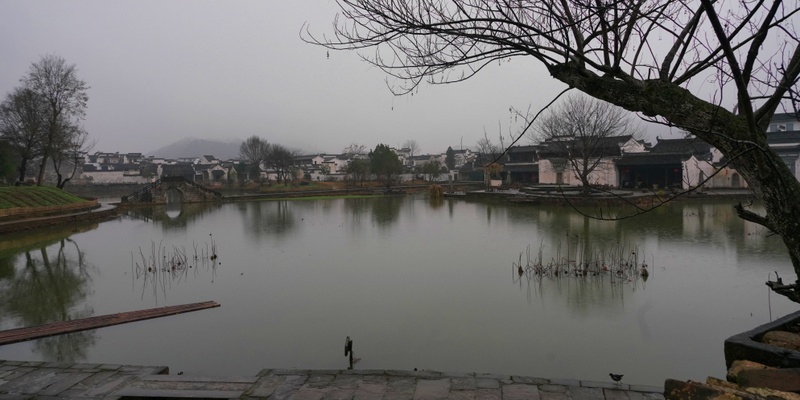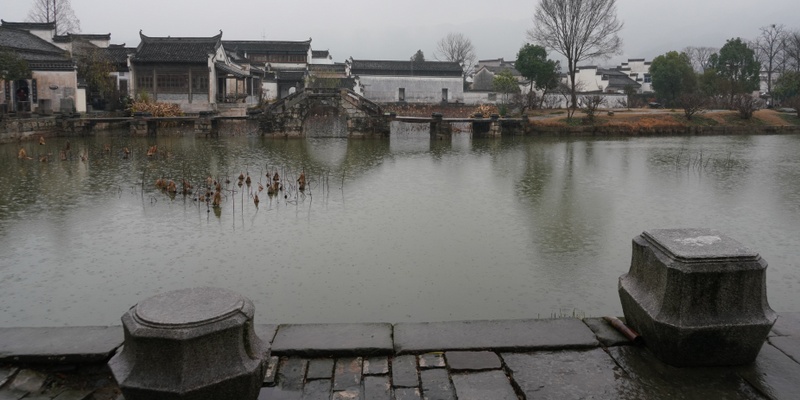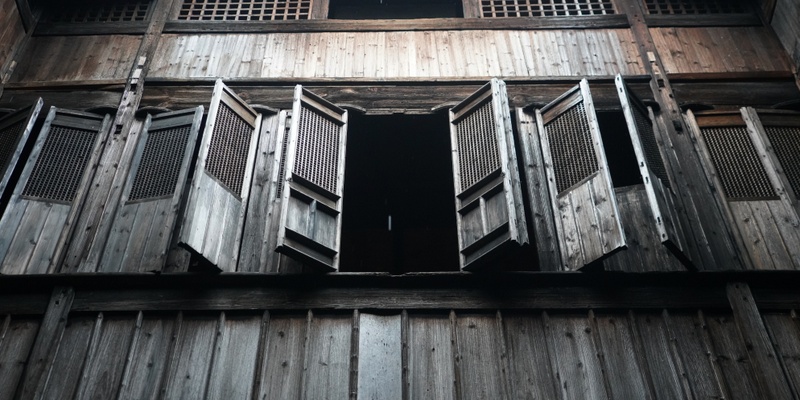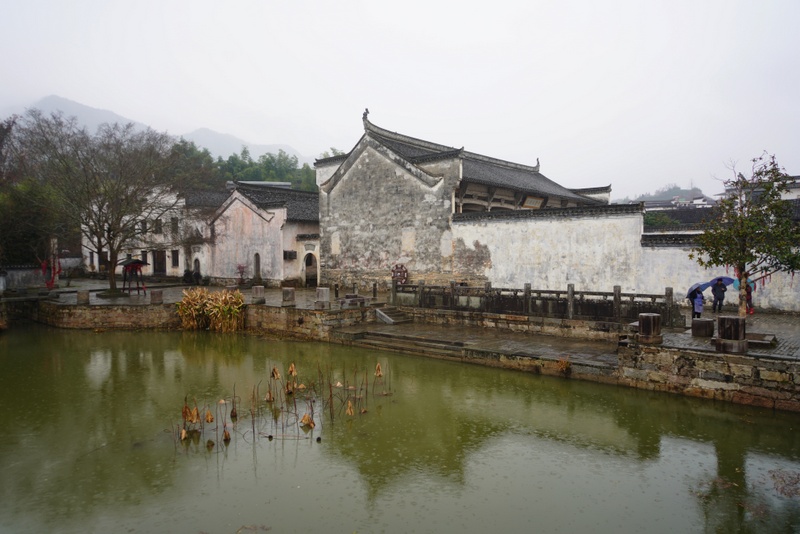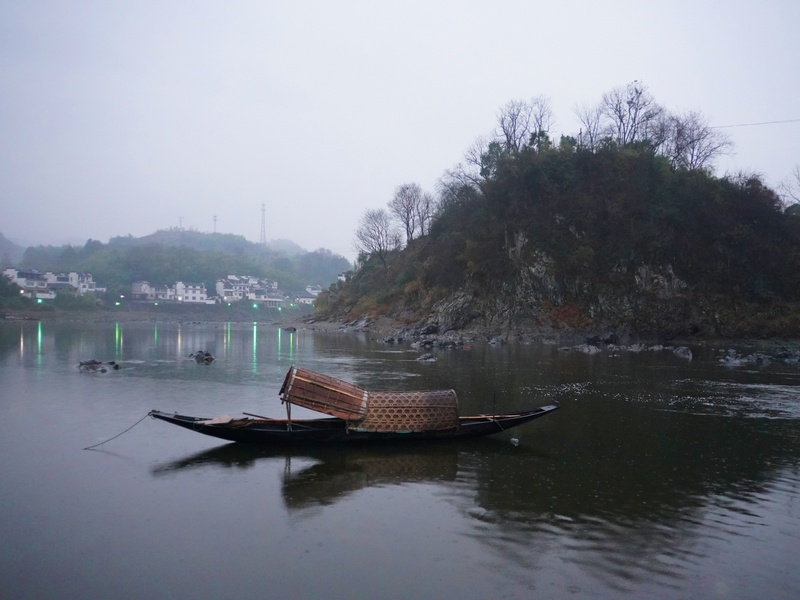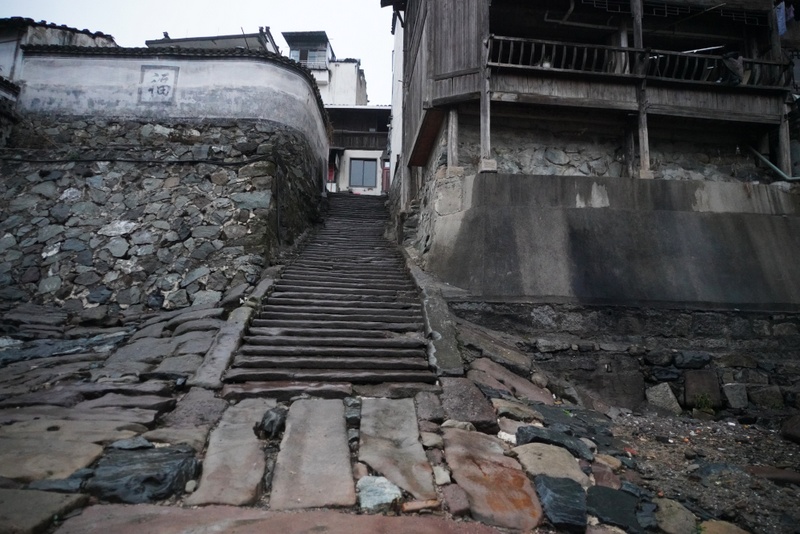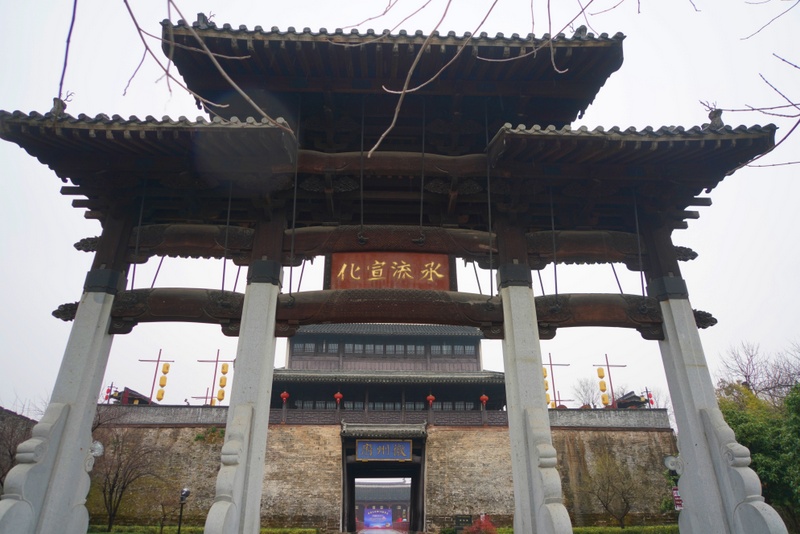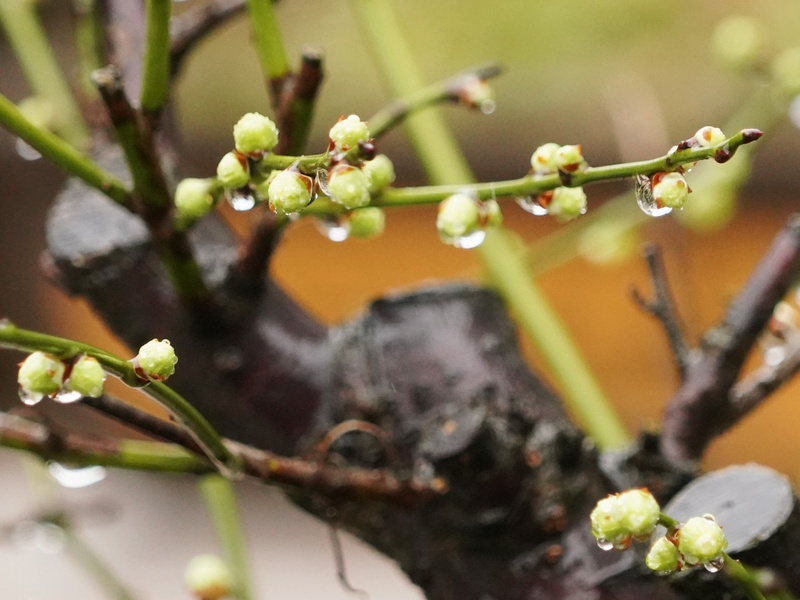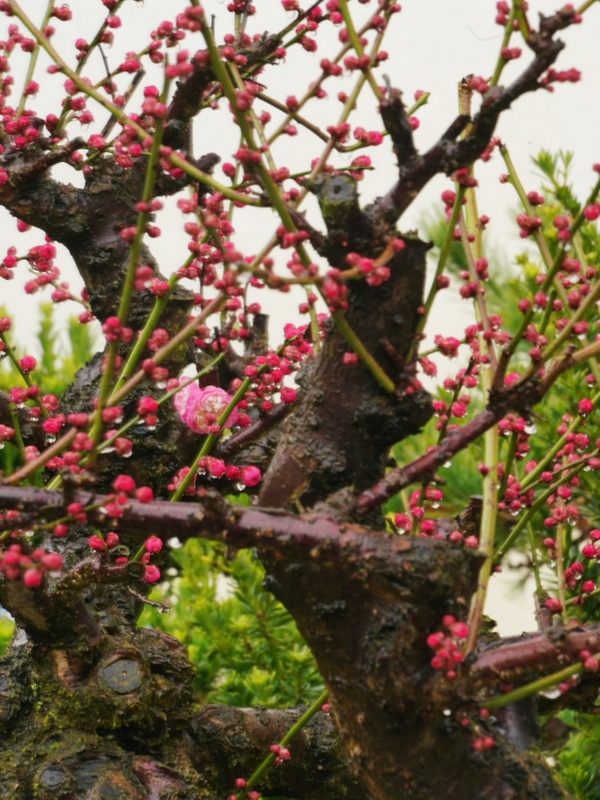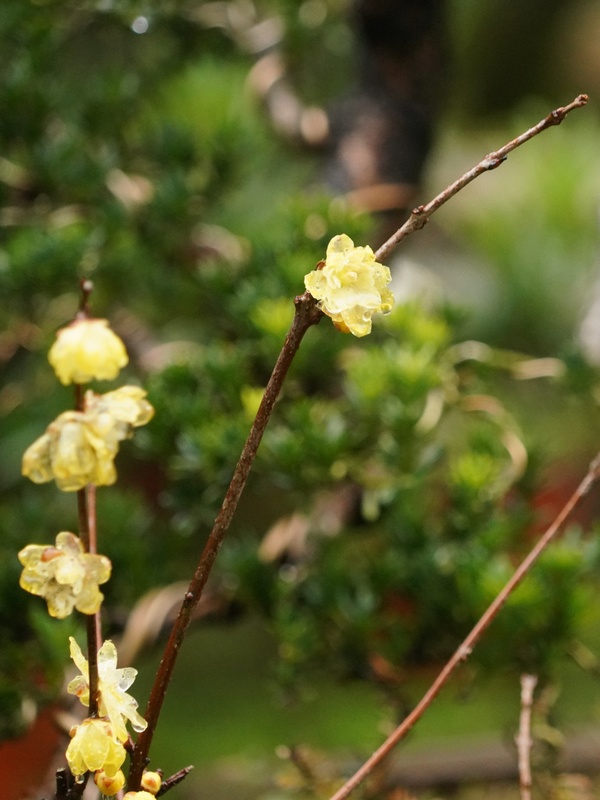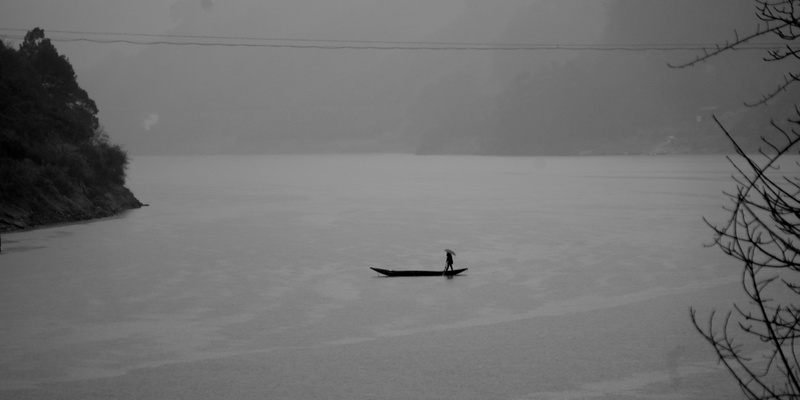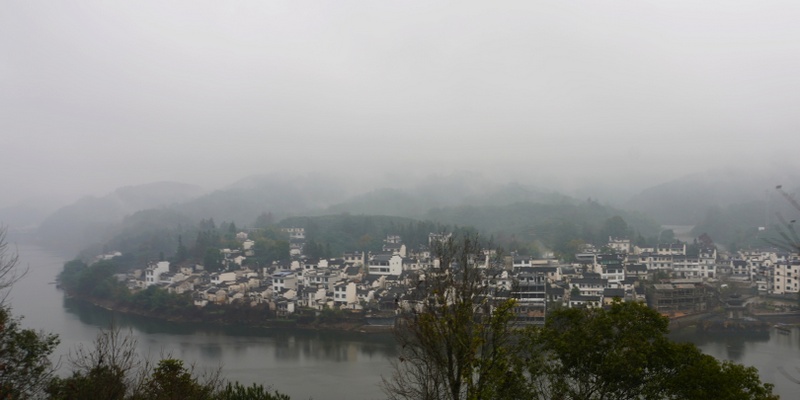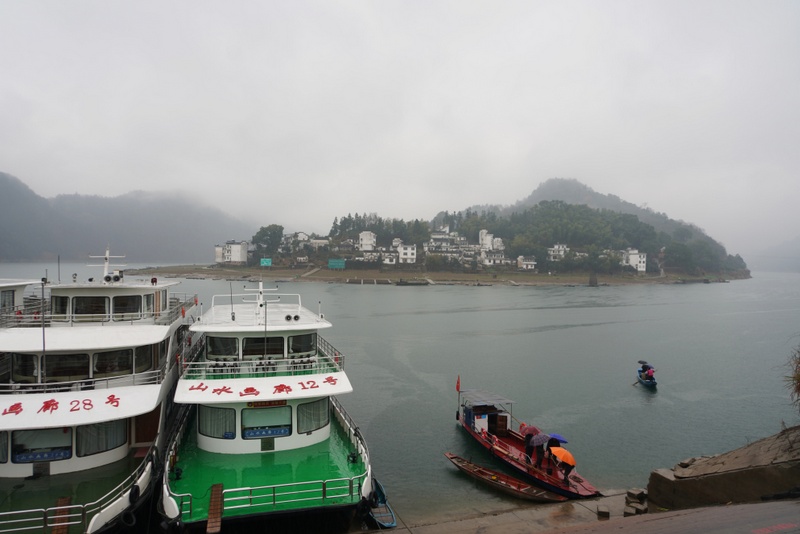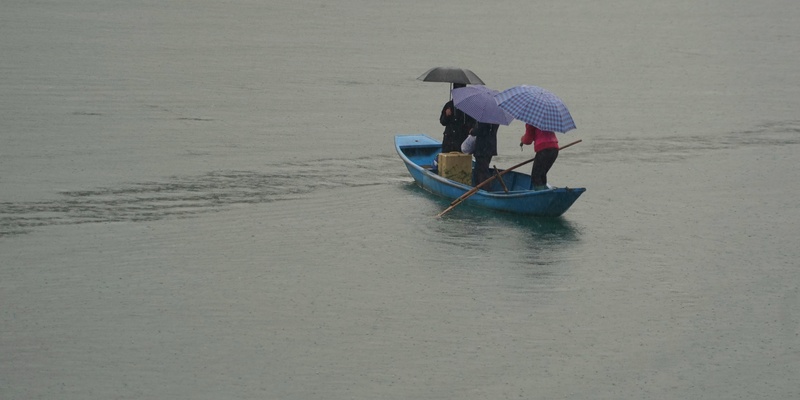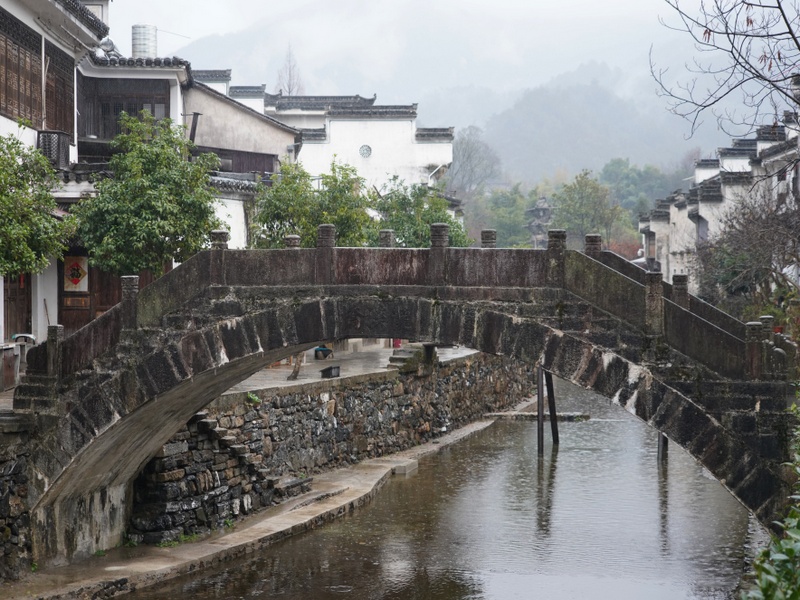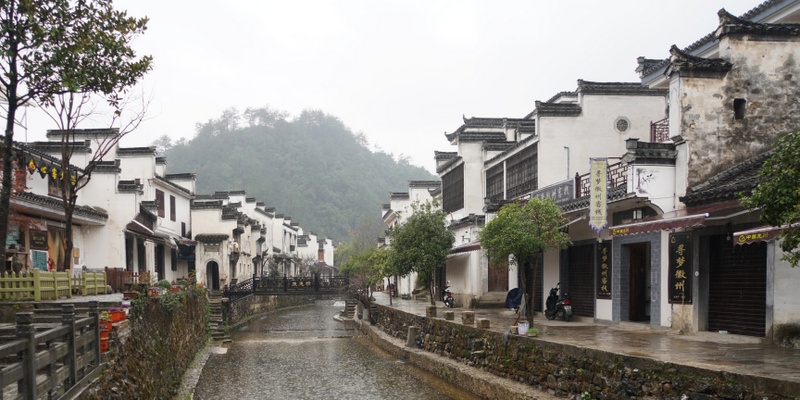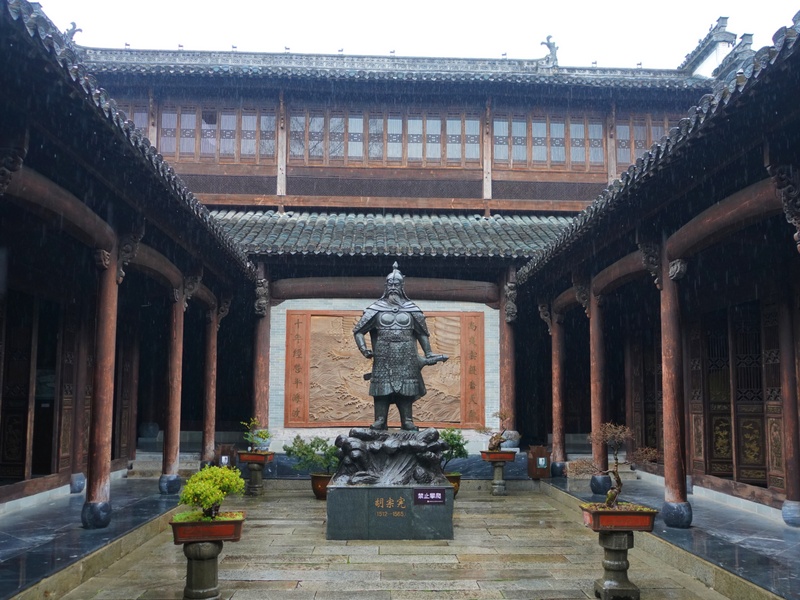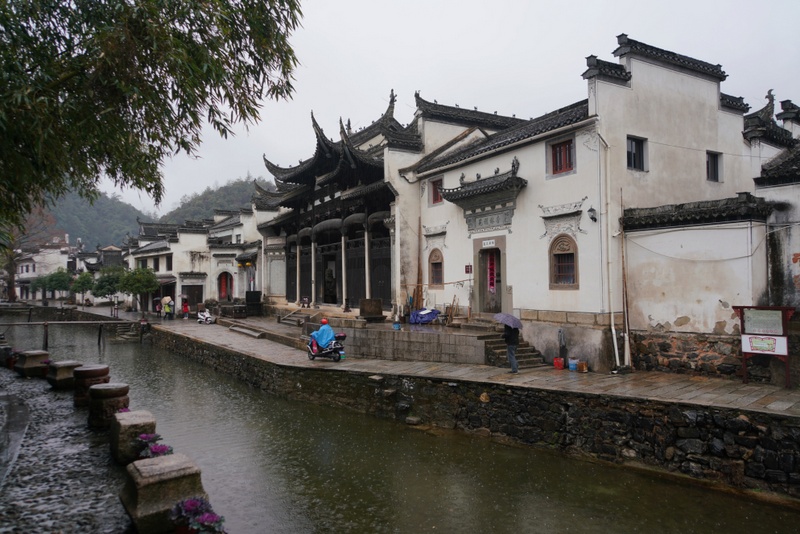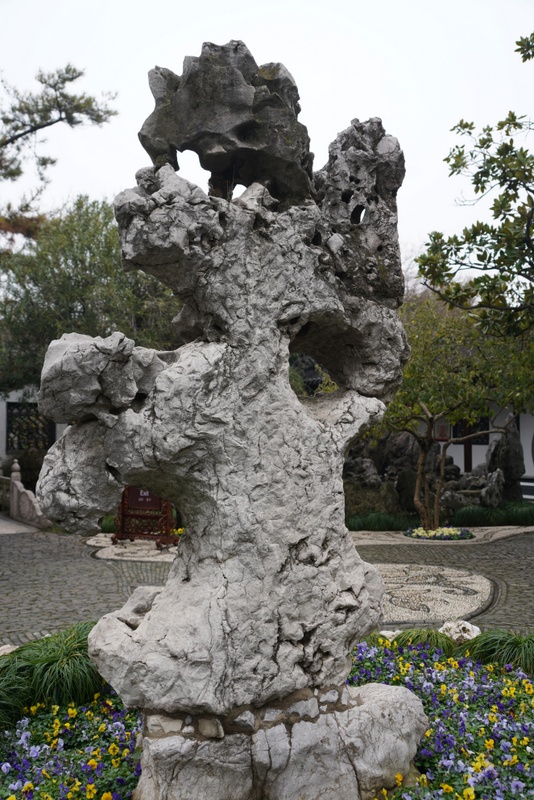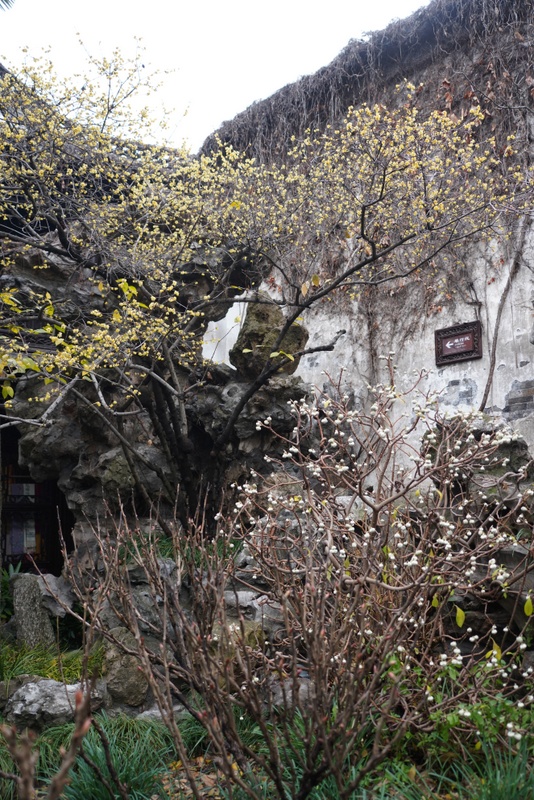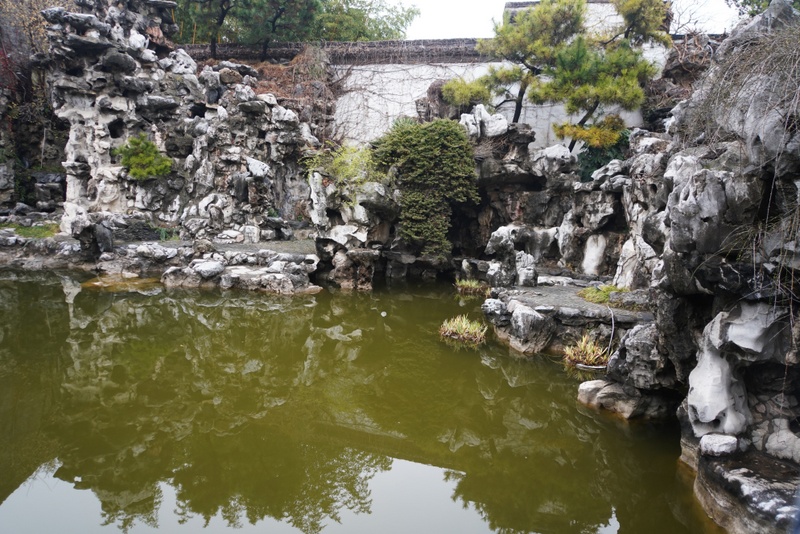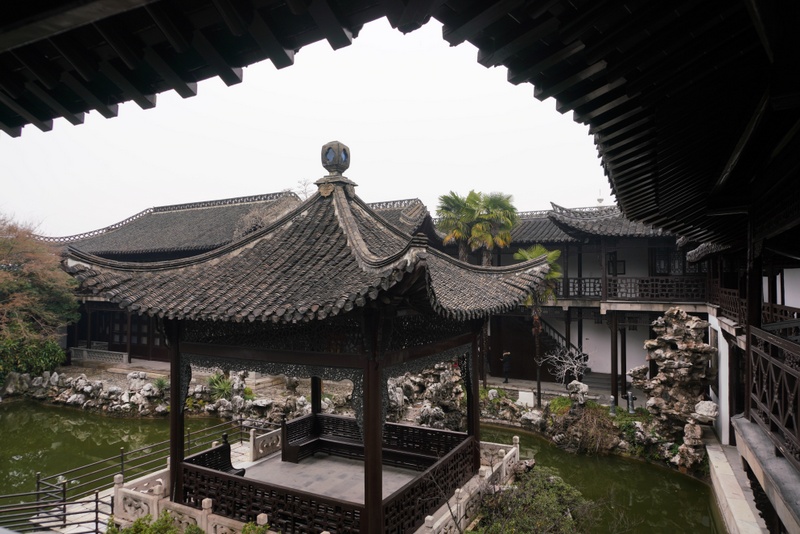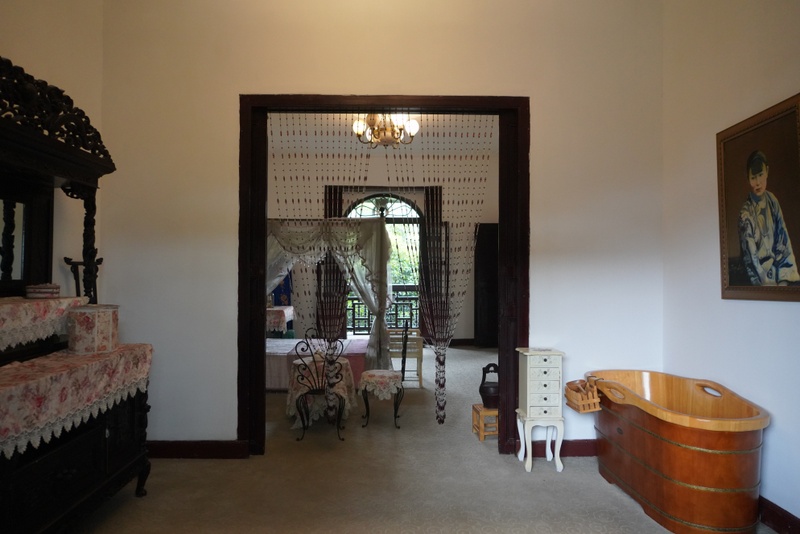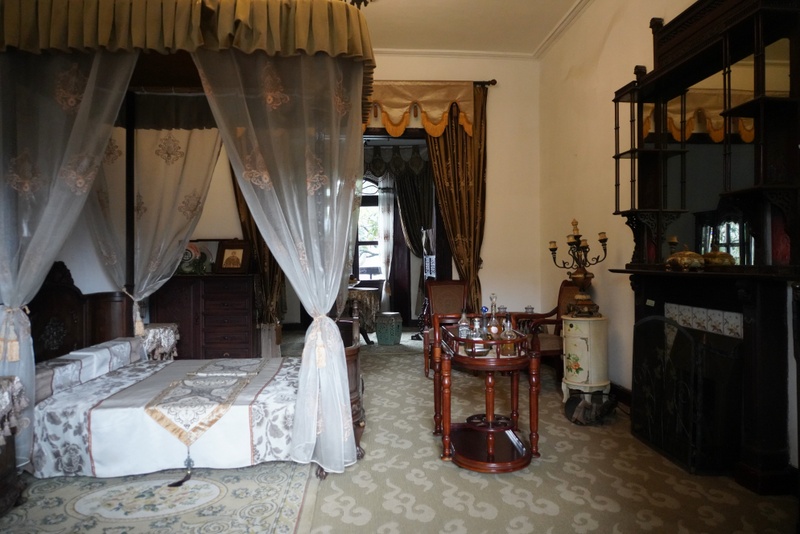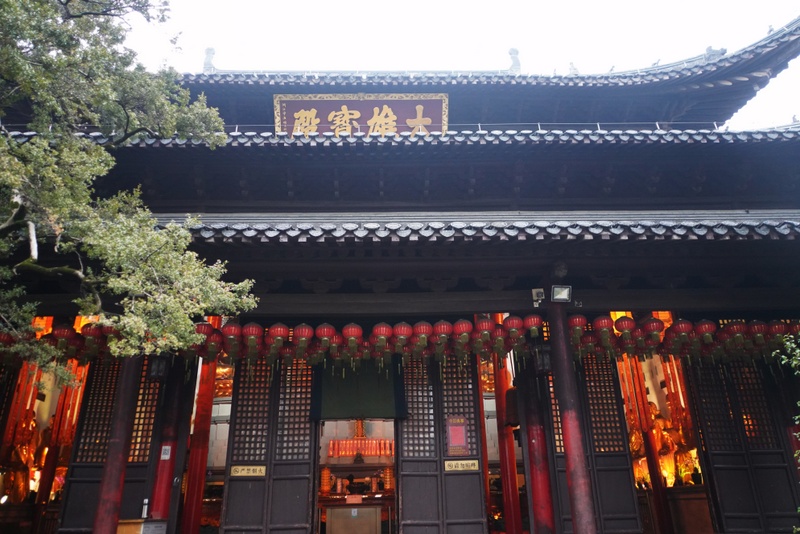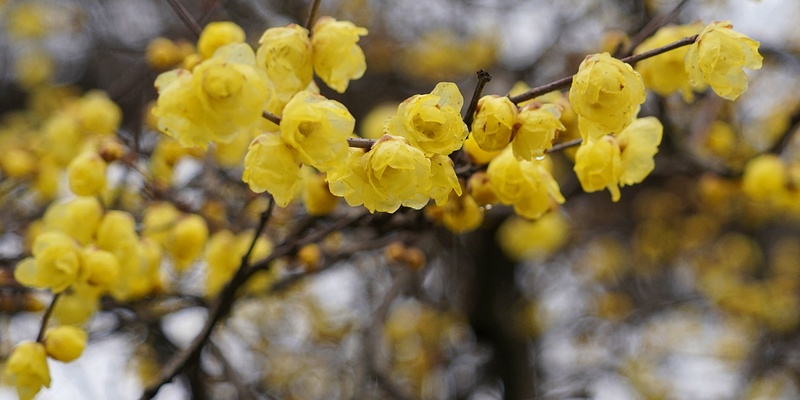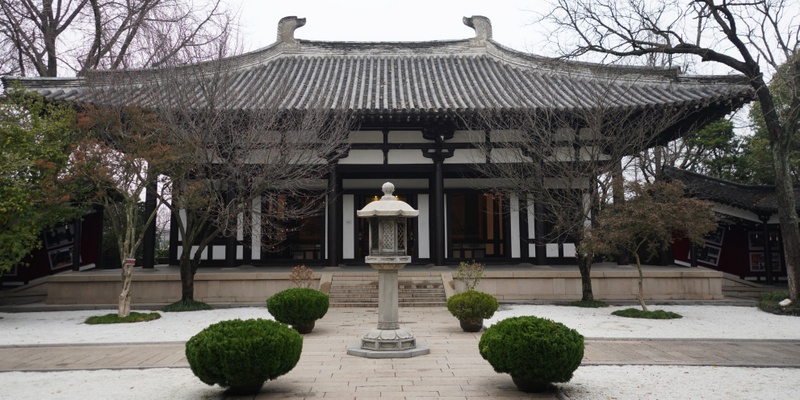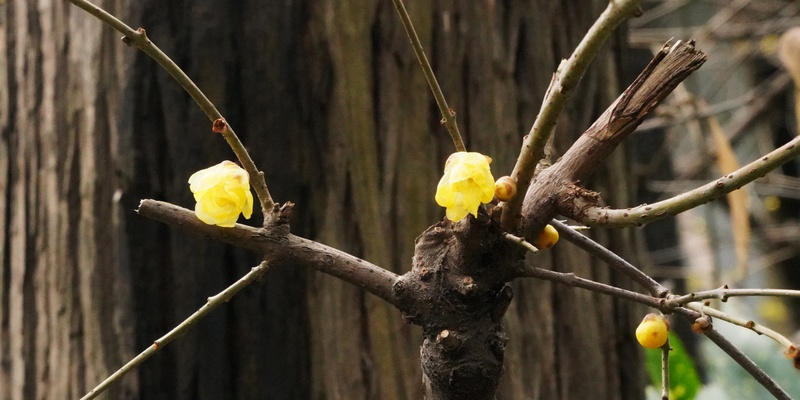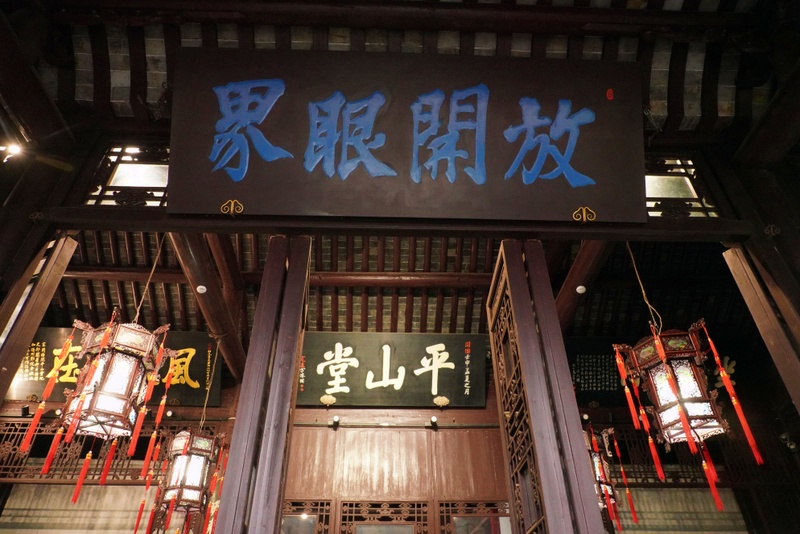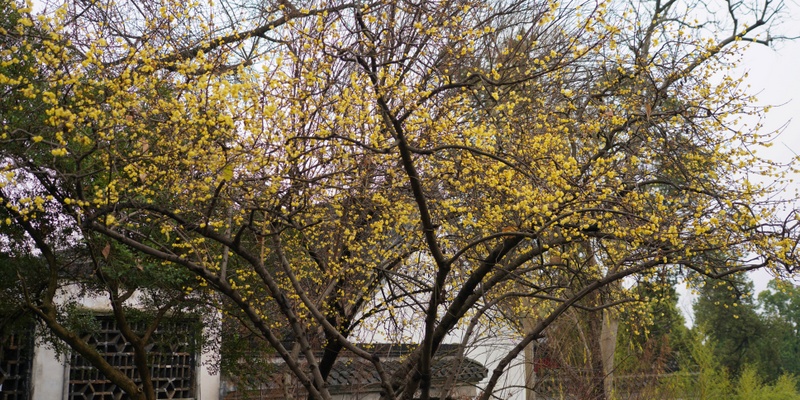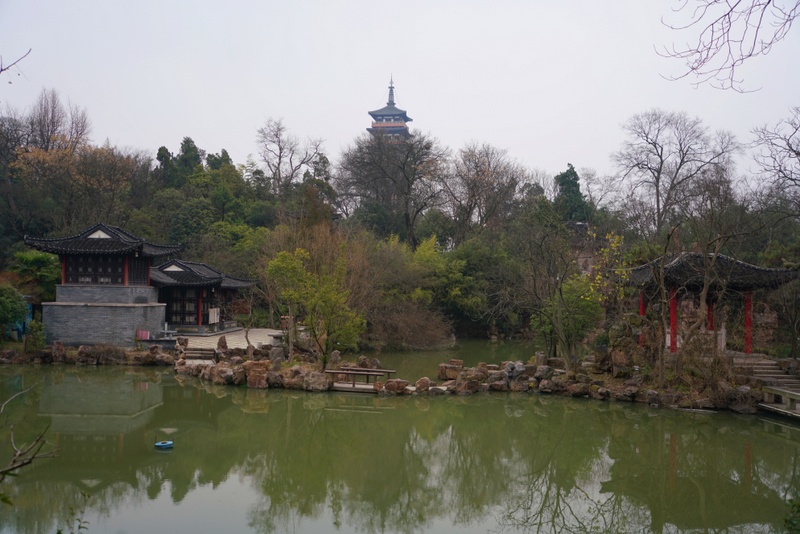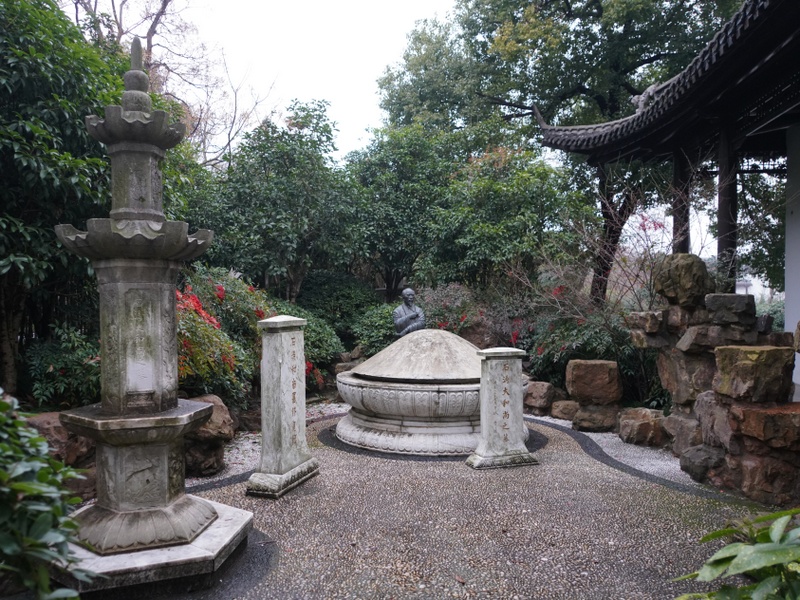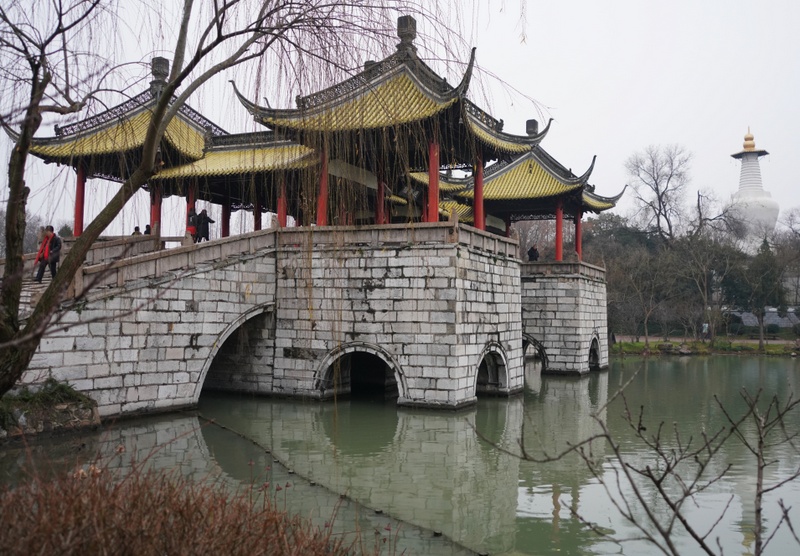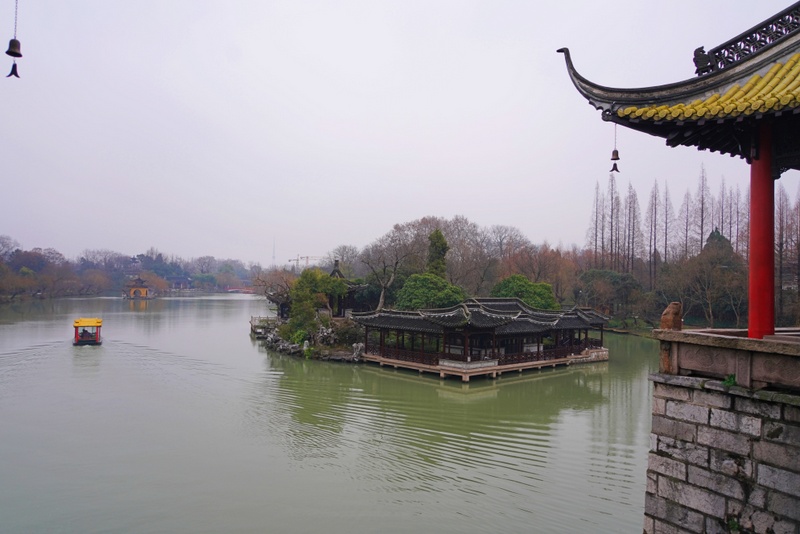Chengkan, Shexian, Longcun & Yangzhou January 9 -12
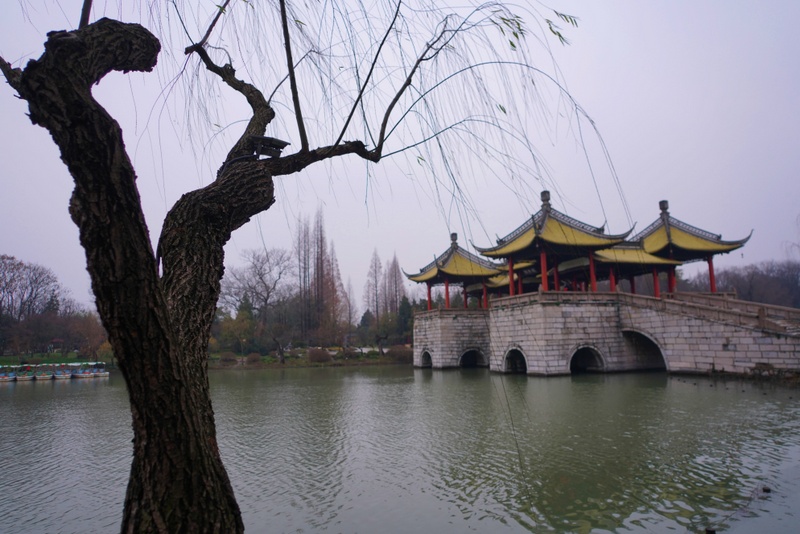
Slender West Lake, Yangzhou 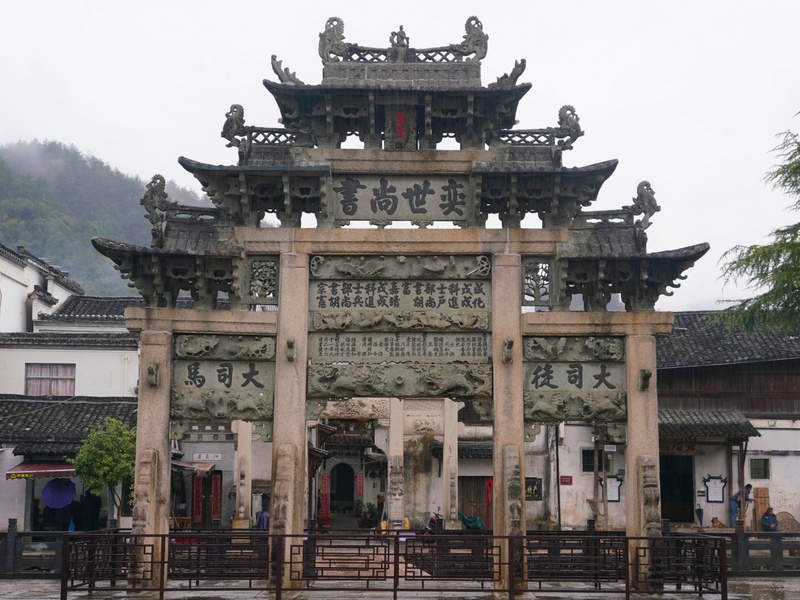
Longchun
January 9 Thursday: Sunrise at Huangshan – Chengkan – Shexian
The chance for sunrise was 40%. I love to watch sunrise at the ‘Begin -to-Believe Peak’. But it would take an hour to get there and another hour to walk back. As a result, we returned to the ‘Stone Monkey Watching the Sea’ for the last time.
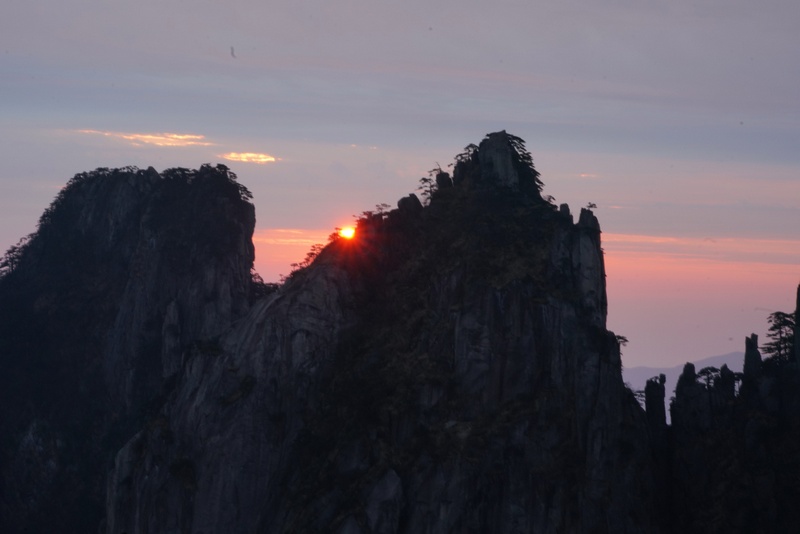
Sunrise 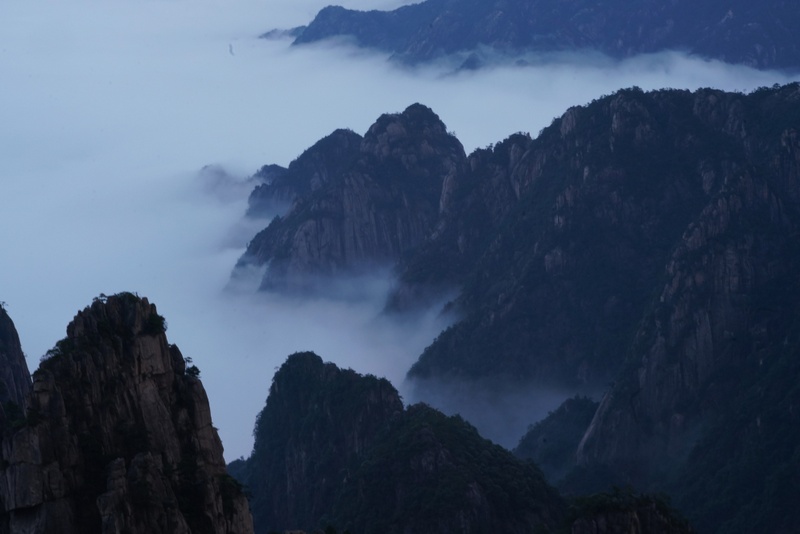
Sea of Cloud
The sunrise was not as beautiful as the one we watched the previous day. But the sea of clouds was fast moving and more impressive.
It started to rain after sunrise. After breakfast, I returned to ‘Dispelling Cloud Pavilion’ for the last time before taking the Taiping Cable Car at 10:30 pm. It was the first time I took this cable car and found the landscape and scenery in the mist most dramatic and breath-taking.
Today, we paid RMB600 for a 6-seater vehicle for a day. Our driver from Hongcun met us at the carpark around 11 am. It took us an hour to return to Tangkouzhen to pick up our luggage.
We had lunch in the same restaurant. It was after 1 pm when we set off for Shexian in Anhui Province.

Though it was raining and miserable, we continued with our sight-seeing journey in high spirit. As we would not have much time before dark, we decided to spend the afternoon in Chengkan 呈坎(also known as Eight Trigrams Village 八卦村) with a history of over 1000 years. Emperor Qin after unifying China in 221 BC, established the She County. At the end Tang Dynasty, two brothers of the Law family moved here.
The location of the village had been chosen owing to its good feng shui. The village surrounded by eight hills and the surrounding fields are laid out in the form of ‘eight trigrams or hexagrams (bagua) which is China’s ancient fundamental philosophy.
The village has over 100 traditional houses from the Ming and Qing Dynasties. Famous for its architecture with colourful paintings and beautiful carvings made of wood, stone and brick, the village has been regarded as the museum of ancient architecture and buildings.
There were few tourists and we had a 2- hour stroll in the village in the rain. Houses had been built in a narrow stretch of land bounded by a lake and a stream.
The village is like a maze with many narrow alleys. We visited a couple of grand traditional houses.
The last stop was a grand ancestral hall of the Law family with beautiful wood carving and painting. It was after 4 pm when we got back to our car.
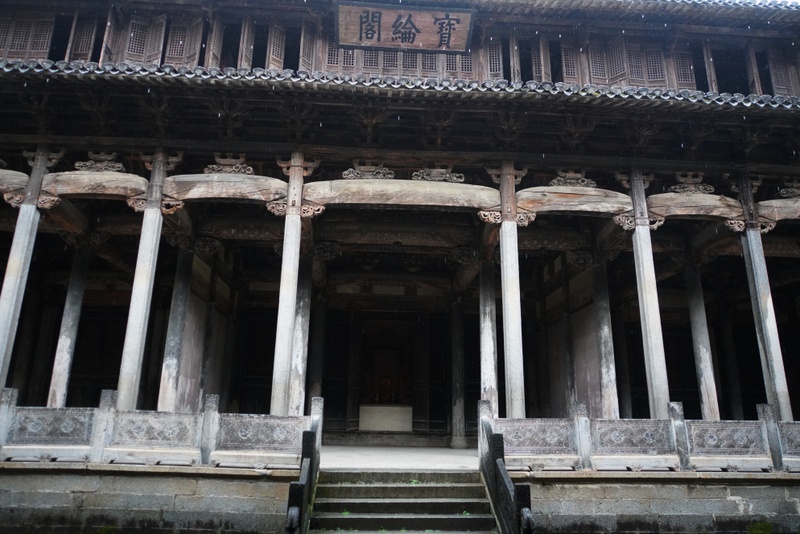
We proceeded to Shexian formerly known as Huizhou Ancient City. It together with Lijiang Old Town, Pingyao Ancient City and Langzhong Ancient City are known as China’s four ancient cities.
On the way, we asked the driver to take us to Yuliang渔梁, an ancient town with a famous 1400-year-old dam across the Xin’an River 新安江, a 373-km-long river connecting ancient Huizhou (present Huangshan City) with Qiandao Lake 千島湖in Zhejiang province. Construction first began in the Tang Dynasty and reconstructed in the Ming dynasty, the dam made of stone and measuring 140m long and 27m wide at the bottom and 4m at the top, is one of the rare ancient rock-rolling dams in China.
Yuliang town was once an important port during the Ming and Qing Dynasties. At its heyday, some 300 boats were mooring here with shops and inns lining the main street.
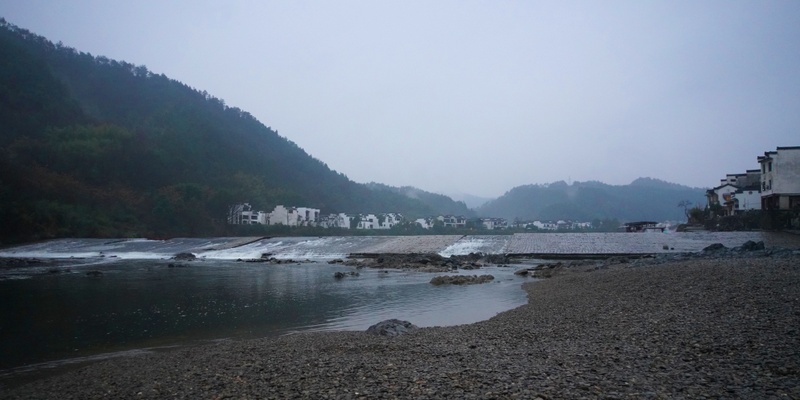
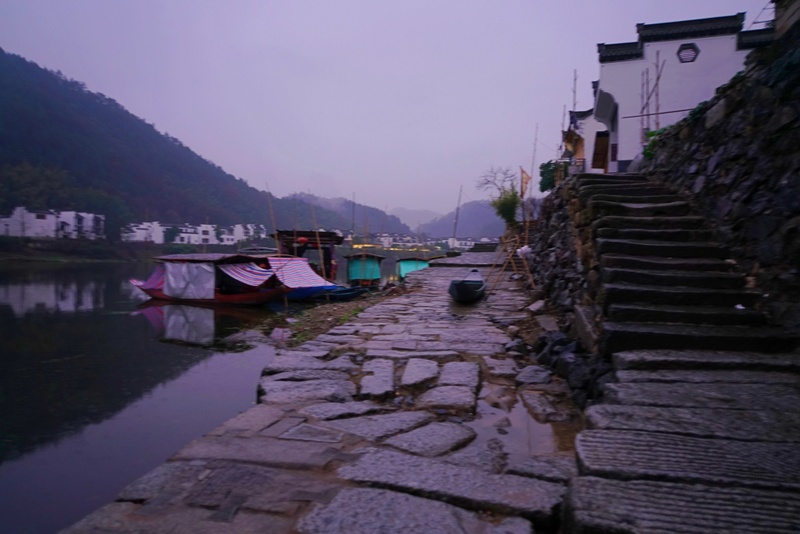
When strolling along the ancient street in dim light and looking at the old houses, I felt like travelling through a time tunnel. I am glad that the place still retains an air of yesterday!
We also walked in silence along the river bank and soaking in the atmosphere. As it was late, we were alone on the dam. Unfortunately, shortly afterwards, horrible artificial green leon lights along the river bank were turned on. It spoilt everything!
I often find beautiful cultural and natural attractions in Mainland China being ruined by poor design, taste and management. For this spectacular setting, history and landscape with ancient streetscape, traditional houses and a most impressive dam, I am sure the site as well as its spirit would be much better preserved and presented elsewhere with a deeper respect for history and culture and appreciation of beauty.
We arrived at Parkview Xinan Hotel around 6 pm. This hotel, a former government guest house for important guests, is spacious and elegant.
The receptionist recommended us a restaurant opposite the river. We had a pleasant walk on a lit-up bridge over Xin’an River. We ordered as many as eight local dishes as recommended by the manager. The dinner only cost RMB600. Fantastic value!
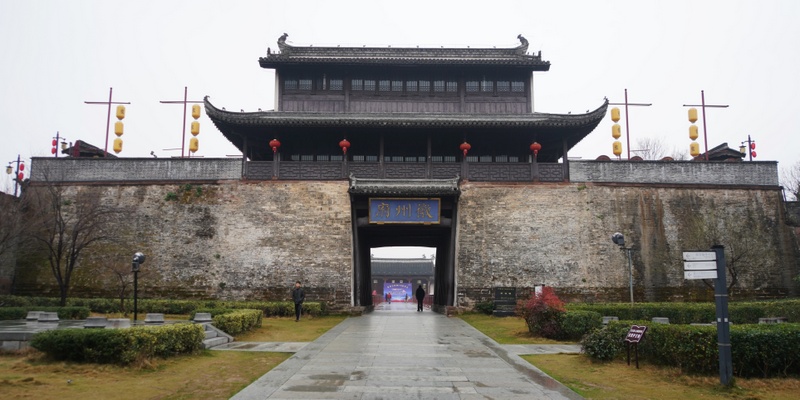
We were full and desperate for exercise. Luckily, we were able to stretch our legs for almost an hour. We crossed the river and strolled leisurely in the ancient city with over 2000 years of history.
First established in the Qin Dynasty, it served as government seat from Tang Dynasty. Today, there are still many old buildings, streets and alleys, city wall and over 400 memorial archways and houses.
The main scenic spots include the 500-year-old Xuguo Stone Archway 许国石坊/大学士坊 (the only octagonal memorial arch in China built to honour merit, filial piety and righteous), Huizhou State Office (a typical Huizhou style architecture in grand scale), Hui Garden and Doushan Street.
As all the attractions and shops were closed, we did not stray beyond the main street. Sadly, we could not see the unique Xuguo Stone Archway which has been enclosed for repair. We also could not make our way to the famous Doushan Street, a long and secluded ancient alley with houses of rich Huizhou merchants.
January 10 Friday: Xin’an River – Longchuan – Nanjing
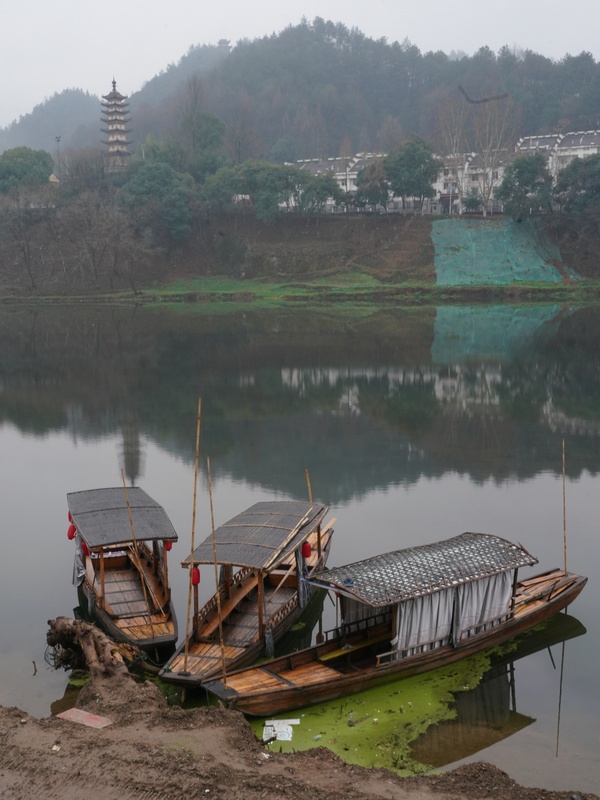
After an early healthy and wholesome breakfast, I went out for an hour’s walk along the river and revisited the old town.
We planned to drive along Xin’an River and visit a couple of villages on our way to Nanjing. Today, we paid RMB1600 for a transfer to Nanjing. We were disappointed when the new driver arrived with a smaller 6-seater vehicle for a long journey.
It was still raining when we set off at 8:30 am. We asked the driver to take us to Maifayuchuan 賣花漁村a village that specialises in nurturing bonsai. I first heard about this place when I saw a beautiful plum bonsai in a guest house in Hongcun.
The village hidden in a valley was very isolated and not accessible. We were excited to see for the first time green plum bonsai. Leung who loves flowers, planned to buy one for RMB300. But transportation is a problem. At the end, he could not get what he wanted. Leuk however found and bought a small one for RMB 70. He carried it by hand all the way back to Kunming.
We followed the Xin’an River and stopped at Shenduzhen 深渡鎮 for lunch. From here, there are cruise boats taking tourists to Qiandao Lake or upstream. The views along this stretch of the river are supposed to be spectacular especially during spring time. But today it was too misty, windy and cold: the place was totally deserted.
Our next stop was Longchuan 龍川, an ancient village with 1600 years of history. Nestled between Feng and Chaohu Mountains, Longchuan(literally means ‘Dragon wasCreek’) with a unique boat-shaped layout has good feng shui and very picturesque. During the Eastern Jin Dynasty, a high-ranking government official surnamed Hu 胡 led his extended family in a migration south from Shandong Province.
It was most atmospheric when we walked along the creek where rows of traditional homes were built facing water with hills in the back. The bank of the creek, the main thoroughfare, is known as the ‘Water Street’.
We followed our guide and stopped at a few houses on the Water Street. Then we arrived at the Yishi Minister Arch constructed in 1562 to formally honoured Hu Fu 胡富(1454-1522), Finance Minister and Hu Zongxian 胡宗憲 (1512-1565), Minister of National Defence. Its engravings are extraordinarily exquisite and well-preserved. No doubt, the arch is a masterpiece of Hui-style stone carving.
Next, we arrived at the official residence of Hu Zongxian who defeated pirates from China’s eastern seaboard. In addition to his position as the Minister of National Defence, he had also been appointed governor of Zhejiang and Fujian provinces. He was the person who marked the Diaoyu Islands as part of Chinese territory for the first time.
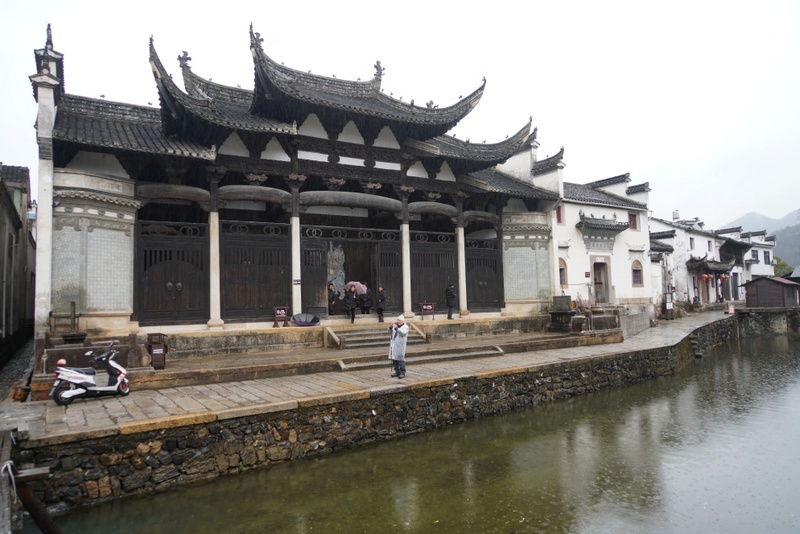
Finally, we stepped into the grand and most exquisite Hu Family Ancestral Hall which was first constructed 1600 years ago. It has undergone several renovations. Spanning a total area of 1,564 m2, the hall showcases folk art incorporating many characteristic decorative elements of Huizhou-style architecture, including brick, wood and stone carvings as well as colourful mosaics. The 600-plus woodcarvings are particularly exquisite. No photography is allowed.
Ancestors of President Hu Jintao (2003-2012) came from this village. I have never seen such a beautifully preserved wooden ancestral hall. It is not surprising it has been described as the “Museum of Woodcarving Art” and has been declared by the State Council as a national relic.
We departed before 4:30pm and drove non-stop for four hours in the rain. It was after 8 pm when we arrived at Phoenix Palace Hotel in Nanjing南京. The driver had a long day and we gave him RMB1700. He was happy. We were relieved when he said he would take a rest and drive back to Hongcun the next day.
We were hungry and had shabu-shabu with beef, fish, fish ball, lamb and vegetables. The bill was less than RMB400 for five. Very cheap!
January 11 Saturday: Yangzhou
Flora, Leung and I have been in Nanjing a few times. We came hoping to find early plum flowers. But it was too early for the flowers to blossom. As a result, we decided to take the bus to Yangzhou揚州. I have never been to this historical city which was one of the wealthiest cities in China known at various periods for its great merchant families, poets, artists and scholars.
Wai Leuk and Isabel on their first visit to Nanjing would stay in the city to visit Sun Yat-sen Mausoleum and museums. We checked the bus timetable online and planned to take the 9:10 am bus from the East Bus Station. When we arrived, we were told there was no bus till 9:40 am. The ticket is RMB45 pp. But without knowing, we were charged RMB5 each for insurance.
Yangzhou is only about 100km east of Hangzhou. It was after 11 am when we arrived. Immediately we bought a return ticket at 5:45 pm. This time, we told the ticket office we already had travel insurance and did not pay an extra RMB5.
We would only have six hours in Yangzhou. How did we spend our precious time?
First, we took a taxi to He Yuan 何園 (Ho Family Garden), the best-known private garden of the late Qing Dynasty and one of the 20 first-class key parks in China.
He Yuan built in 1883 by He Zhidao, a government official during the reign of Emperor Guangxu, is a private garden with a residence that combined western architecture and brilliant features of a private garden in Jiangnan (meaning region south of Yangtze River).
The garden covers an area of 14,000m2 (out of which half is covered with plants). The garden had incorporated elements of western landscape architecture and created its own style with eastern and western features. It comprises three parts namely the west and east gardens, the residential area and courtyard, and the mountain villa.
Its main features include Yuxiu Building, Boat Hall, Double-Path Cloister, a 430m two-storied winding corridor, the walls of which are lined with stone tablets carved with lines of classical poetry, Butterfly Hall, Rockery Built with Pieces of Stones and Pond-centred Pavilion.
We spent almost two hours in this expansive residential garden. I have learnt something about the history and achievements of the distinguished He family. What impressed us most was the beautiful wintersweet 蠟梅and the rocks from Tai Lake in the garden.
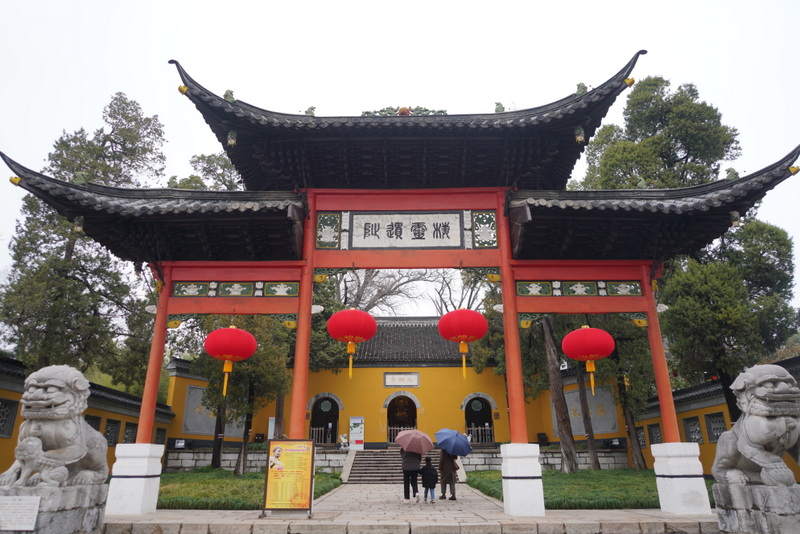
Second, we took a taxi after a quick lunch to Daming Temple大明寺, a large complex located on Shugang Hill. The original temple was built in Liu Song Dynasty (420-479). A nine-story pagoda was built on the temple ground in the Sui Dynasty (420-479). Qing Emperor Qian Long who did not like the name ‘Daming’ literally meaning Great Ming, renamed it Fajing Temple during his visit to Yangzhou in 1765.
The temple was seriously damaged during Taiping Rebellion and in the 20th century. The present structure is a reconstruction dating from the 1930s. The temple consists of three parts.
Central part: Hall of the Four Heavenly Kings and Great Hall.
Eastern part: Pingyuan Hall & the Jianzhen Memorial Hall.
Jianzhen 鑑真和尚(688-763) was the abbot of the temple when an emissary from Japan invited him to lecture in Japan in 742. After five failed attempts, he eventually arrived in Japan in 754 to propagate Buddhism. In 1973, a hall financed with contributions raised by Buddhist groups in Japan and built according to Tang Dynasty construction methods, was built in memory of Jianzhen.
Western part: Pingshan Hall, Si Garden & other features.
Pingshan Hall 平山堂 was built by Song Dynasty scholar Ouyang Xiu in 1048 when he was prefecture chief of Yangzhou. The name derived from the fact that when one looks at distant scenes, the mountains would be at the same level with sight line.
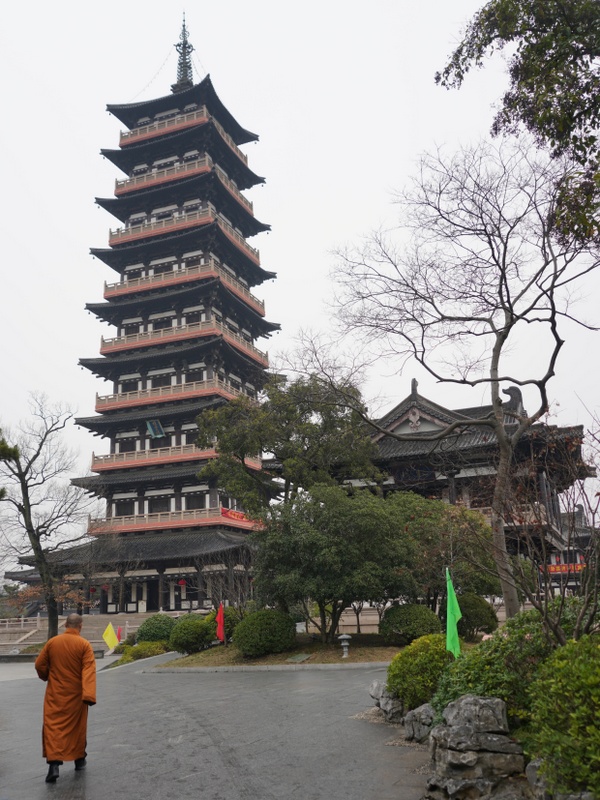
Before leaving the temple, I stopped briefly at the nine-story Qiling Pagoda 栖灵塔 which was first built in the Sui Dynasty between 601 and 604. The present one is new with a lift. As the lift stopped at 4 pm, I did not have a chance to go up even if I was prepared to pay RMB20 for a lift ride. The panoramic view of the expansive temple ground and surrounding areas would be beautiful.
I love the temple ground. I am most impressed by the fragrant of wintersweet which was in full blossom. The landscaped garden is beautiful too.
Third, Slender West Lake 瘦西湖 which is named after Hangzhou’s West Lake. It is a long, narrow stretch of water meandering through the city’s western limits with many scenic spots.
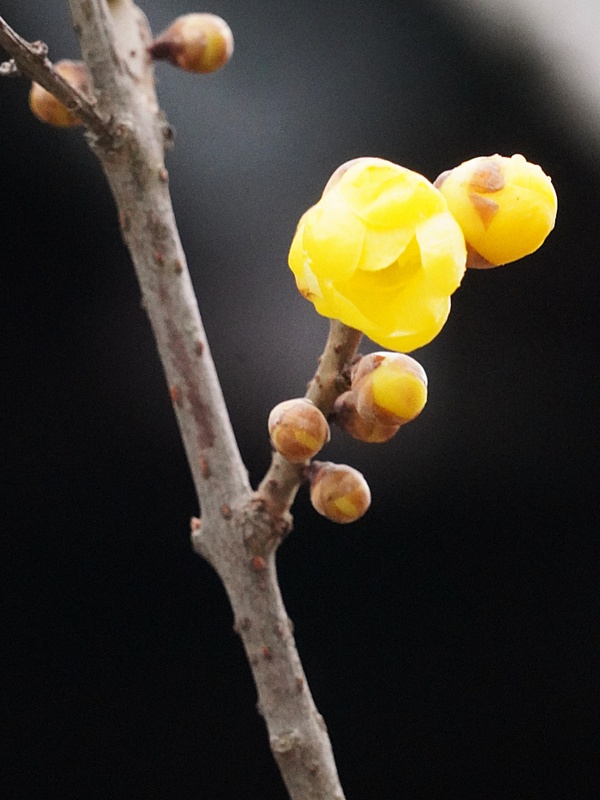
As we had to catch the train, we had less than an hour to enjoy the lake which has many scenic spots including the Lotus Flower Pagoda, Small Gold Mountain, Fishing Platform etc.
We entered through the East entrance, walked along the bank which is lined with weeping willows. The lake has been most beautiful in spring time when plum and peach trees and other flowers blossom.
We crossed the lake and arrived at the bottom of the Lotus Flower Pagoda which resembles the White Pagoda in Beijing’s Beihai Park. Then we had to make our way to the exit at the western side.
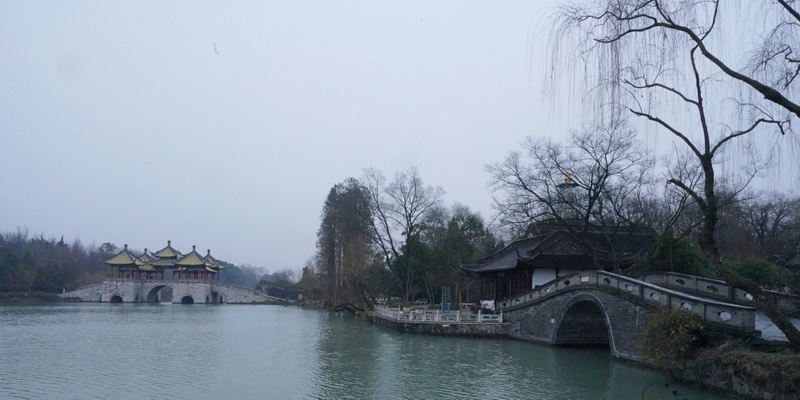
The park is beautifully landscaped. I would return in spring one day to fully enjoy this park and flowers.
We reached the bus station just in time and had a safe ride to Nanjing. We met Wai Leuk and Isabel at a local restaurant close to our hotel and had the best meal of the trip with eight local dishes for RMB600.
January 12 Sunday: Nanjing – Hong Kong
We would part our own way: I would be leaving for Hong Kong around 2 pm; Wai Leuk and Isabel after 7 pm while Flora and Leung the next day. Wai Leuk, Isabel and I checked out before 9 am and had breakfast together. They kissed me good-bye and continued with their sightseeing programme.
As it was drizzling, I was not keen to go to the lake for a stroll. Instead, I spent the morning in a book store in a mall before heading to the airport shortly after 11:30am. The metro to the airport only costs RMB8. But it takes over an hour and a half as the airport is far from the city centre. My plane departed on schedule and I landed in Hong Kong after 5pm after a nice but relaxing short week with Wai leuk and Isabel.
Remarks (This section was written and uploaded on April 30)
I planned this trip around December and invited Wai Leuk and Isabel to join whom I had not seen since their wedding. It was great that Leung and Flora could join. We had a nice easy-going gang of five.
It is amazing how much I have done in a week. I was happy to meet Wai Leuk and Isabel in Hangzhou and spent our first night in Hongcun.
We had a wonderful time in Huangshan which is one of my favourite destinations in China. Its majestic landscape and scenery in all seasons are unrivalled. This was my second visit and I stayed again in Xihai.
The weather had not been perfect: it rained heavily on the second day. But it worked magic bringing the much-needed rain to the area. As a result of the rain and drop in temperature, we were able to enjoy the sight of sea of clouds at sunrise and very special misty frost scenery on Day 3. Wai Leuk and Isabel have been most lucky to see sea of cloud, beautiful sunrise and sunset and misty frost scenery on their first visit to Huangshan.
After Huangshan, we visited a few atmospheric traditional villages at its foothill. Chengkan, Shexian, Yuliang, Shenduzhen and Longchuanare picturesque and full of history. I would certainly return in spring to explore this region.
I have heard a lot about Yangzhou which is close to Nanjing. I was glad to visit this historical city for the first time. It is more tranquil with many attractions. I can spend a few days in Yangzhou.
After this short trip, I already start planning future trips to the region. First, I hope to see Huangshan in autumn when visitors are allowed to follow the trail to reach the Lotus Peak(1864m) or the Celestial Peak (1829m) and to visit the West Sea Canyon area. I would stay in other locations next time. I would also return once more in winter to discover Huangshan in snow.
Second, I would return to Nanjing and Yangzhou to see plum blossoms in February one year.
Third, I love the traditional villages in this region and hope to spend a week to explore the region.
On reflection, Covid-19 was spreading in Wuhan at the end of last year. I was not aware of the seriousness of the virus when planning the trip. As at now (April 30, 2020), the virus has infected more than 3.2 million people worldwide killing at least 227,000 according to Johns Hopkins University. We have been very lucky to be able to make this trip and returned to Hong Kong safe and sound. I pray the pandemic will be over as soon as possible and life can gradually return to normal.


